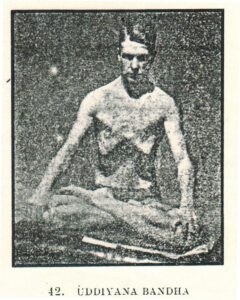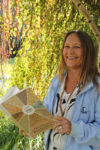Maha Bheda is the 7th Kriya in this series of 20 Tantric Kriyas.
Maha means “great,” and bheda is “separating” or “piercing”. According to the Hatha Yoga Pradipika, maha bheda helps us to pierce through the individual level of consciousness for each chakra. You can learn more about these states of consciousness on pages 140-142 in Letters from the Yoga Masters.
Classically, Maha Bheda is done in conjunction with Maha Mudra and Maha Bandha. In this series of Tantric Kriyas, we will learn each of these three similar techniques that flow together.
Let me explain a few important details first:

- This practice is done while sitting in siddhasana as shown in the photo above. The lower foot is pressing the heel into the perineum at muladhara chakra. The upper foot rests on top of the lower foot with the heel pressing into the pubic bone at svadhistana chakra. Of course, if this seat is not comfortable, choose one that is.
- Your breathing will be with ujjayi and amritpan khechari mudra (the tongue curled back into the soft palate).
- This practice integrates our previous practices of rotating our consciousness up the arohan (front psychic passageway), and down the awarohan (back psychic passageway). You can acknowledge each chakra as you move past them with your consciousness.
- Keep your eyes softly open during this practice.
- When you complete the exhalation and return to muladhara, you will hold the breath out and apply the three bandhas (aka bandha traya).
This is a strong practice to apply all three bandhas, so be sure you have been taught these and practiced them with your teacher prior to doing this. If not, then just briefly hold the breath out without this strong “bandha traya”.
With the application of all three bandhas, the solar plexus area will draw in deeply toward the spine with the breath held out, as shown in the photo of Hari (so be sure you have an empty stomach). You can learn more about bandha traya on pages 71-74 in Letters from the Yoga Masters.
So let’s begin. Sit in siddhasana or your chosen comfortable seated position. Lower the head and engage mula bandha and repeat “muladhara” three times. Inhale slowly, with eyes softly open, using ujjayi breath and khechari mudra, moving your consciousness up the front passage (arohan) to bindu. Your head moves up as you pass through each chakra with your inner vision.

Retain the breath and repeat mentally “bindu, bindu, bindu.”
Exhale slowly, descending down the back passage (awarohan) and when you reach muladhara chakra, hold the breath out and apply all three bandhas as long as is comfortable: jalandhara, uddiyana and mula bandha.
Release the bandhas, inhale and repeat “muladhara, muladhara, muladhara.”
Repeat this process twelve times, or optionally repeat it only 6 times. Below is a video to help guide you through the practice. You can read more about it on page 153 in Letters from the Yoga Masters.
If you are just joining us here, I recommend you refer back to the SOYA blog to learn the practice of Arohan and Awarohan and the previous kriyas. Remember, these practices are intended to thread one into the next, until eventually all 20 kriyas are completed in one sitting. Of course many of us do not have time to do this, so they are still very beautiful practices completed on their own. Enjoy!

Marion Mugs McConnell is the author of Letters from the Yoga Masters: Teachings Revealed through Correspondence from Paramhhansa Yogananda, Ramana Maharshi, Swami Sivananda, and Others, published by North Atlantic Books copyright © 2016 ISBN 978-1-62317-035-6. This is an excerpt of the book, and reprinted by permission of North Atlantic Books. All photos are used with permission.


Recent Comments